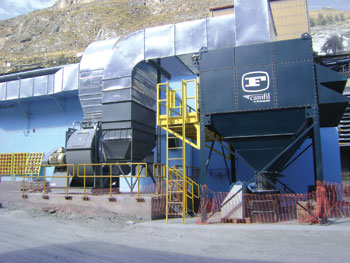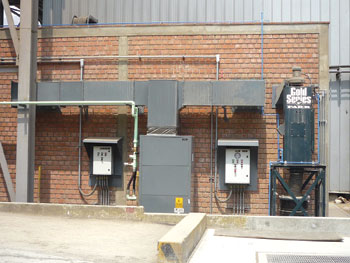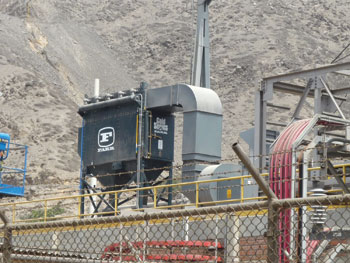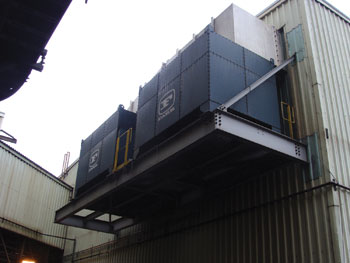By Pablo Rocasermeno
Guidelines on how to apply a concept that is appropriate for mine and plant environments, where dust generated during crushing, screening and conveying must be controlled to protect workers, office spaces and sensitive equipment
 This 48-cartridge dust collector pressurizes and conditions the control room of a gold-silver mine located at an elevation of more than 15,000 ft (4,572 m).
This 48-cartridge dust collector pressurizes and conditions the control room of a gold-silver mine located at an elevation of more than 15,000 ft (4,572 m).
Pressurization is a well-known ventilation technique in which a positive or negative atmospheric pressure is maintained in an isolated or semi-isolated environment. A clear way to illustrate this principle is the example of the health care industry, where pressurization has been used for many years for infectious disease control.
A patient with an immunodeficiency disorder will typically be housed in a positive pressure isolation room, which maintains a flow of air out of the room, thus protecting the individual from contaminants and pathogens, which might otherwise enter. Conversely, a patient with a contagious disease will be housed in a negative pressure isolation room, which maintains a flow of air into the room to keep the infection from spreading to other patients and health care workers.
 A small cartridge collector is used to pressurize an electrical room at a mine located in a warm climate. The dust collector is sized for 10% of the capacity of the electrical room’s backpack-type A/C unit used for cooling.
A small cartridge collector is used to pressurize an electrical room at a mine located in a warm climate. The dust collector is sized for 10% of the capacity of the electrical room’s backpack-type A/C unit used for cooling.
In mining environments, positive pressure (known as “inflating the building”) is similarly used to keep particulate or gaseous contaminants out of a room, creating an air barrier between the outside and the inside. If you walk into a positively pressurized environment and open the door from outside, you will feel the “whoosh” of air escaping due to the higher pressure of the air inside the room. This is the desired effect when you are trying to protect the contents of the room from dirty outdoor air conditions, from dust or fumes generated by an adjacent production process, or even from excess humidity that might seep in through walls or other openings. Offices, labs, electrical and server rooms at mine sites are especially prone to dust infiltration that can create unpleasant working conditions while causing problems with critical equipment, especially electronics.
Conversely, in a facility where toxic minerals are being processed, negative pressure may be applied—sometimes in conjunction with containment systems—to prevent the dust generated in a processing space from cross-contaminating other areas of the plant.
To guard against cross-contamination and maintain desired air quality during either positive or negative pressurization, proper air filtration is a necessary component of the process. High-efficiency HVAC filters (ASHRAE-grade or HEPA filters) are the most common solution, but cartridge-type industrial dust collectors can offer an effective and sometimes overlooked alternative for applications where dust loads are extremely heavy and filter life is prohibitively short.
Pressurizing with dust collectors is highly applicable to mining environments, where high volumes of dust are generated during crushing, screening, conveying, etc. Areas that are most commonly protected through pressurization include:
• Control rooms,
• Compressor rooms,
• Offices,
• Quality control labs,
• Substations, and
• Electrical equipment and motor control center (MCC) rooms.
Deciding When to Pressurize
How does an engineer decide whether pressurization is a good choice? Field experience at mines shows us that in most cases it is a good practice to pressurize. The only time that pressurization will not make sense is when the room or space is far away from the dust generation source (crushing plant, concentrator, dirt road, etc.). Yet the decision can’t be based solely on the volume of dust to be controlled, because other factors come into play, such as the type of dust, conditions inside and outside the space, and what (or whom) you are trying to protect.
 A 10-cartridge dust collector is installed on the roof of an MCC room to protect the equipment inside from dusty conditions of this South American copper mine. This equipment is operating above 4,000 m elevation.
A 10-cartridge dust collector is installed on the roof of an MCC room to protect the equipment inside from dusty conditions of this South American copper mine. This equipment is operating above 4,000 m elevation.
If you are protecting electrical equipment that costs $100,000 from damage or from creating a safety hazard due to contact with dust, it makes sense to invest in a $20,000 pressurizing system to protect that equipment. But even less costly equipment containing filters, bearings and lubricants, for example, can benefit from a dust-free environment that reduces maintenance and improves operating reliability. Also, another common reason for pressurization is worker protection; i.e., to comply with regulations for exposure levels of contaminants. Not only will you be in compliance and preserve workers’ health, but morale and productivity will also be enhanced.
Climate considerations might also impact your cost analysis, for example, in colder climates or during winter season, you can take advantage of the “free cooling” and use your pressurizing system for conditioning, saving substantially on air conditioning costs required to keep servers and electrical equipment from overheating.
Return on investment should typically be less than two years for pressurization to be cost-effective, and field experience shows that the payback is often much faster. Though as stated before, in many cases, the main justification is to guarantee a certain air quality in a space to protect something or someone valuable. The technology can be applied whether it is a new construction, expansion or renovation project. Retrofitting of air handling units, although possible, can be more costly and complex depending on the set-up and location.
Deciding How to Pressurize
As noted earlier, pressurization with dust collectors is best suited to heavy-dust loading applications where HVAC filters will not have an acceptable life. In extremely dusty conditions, high-efficiency HVAC filters can quickly become overloaded and may require changeout every few months or every few weeks in some cases, even with pre-filters in place to protect the more expensive primary filters.
 Multiple dust collectors, each containing six high-efficiency filter cartridges, are used to pressurize electrical rooms at a copper mine. The units have been operating for more than two years without a filter change. Blowers are controlled by VFDs and pressure sensors inside the room.
Multiple dust collectors, each containing six high-efficiency filter cartridges, are used to pressurize electrical rooms at a copper mine. The units have been operating for more than two years without a filter change. Blowers are controlled by VFDs and pressure sensors inside the room.
Cartridge dust collector filters, by contrast, are designed specifically to handle high-dust loads in mining and other industrial environments. A dust collector has the capability to automatically pulse-clean its filters using very brief bursts of compressed air that blow dirt off the filter surfaces and down into a collection device. When used in a pressurization system, high-efficiency cartridge filters can last for years before needing replacement.
To determine the best choice for your application, begin with a cost analysis that evaluates the space to be pressurized and compare the two filtration technologies (i.e., HVAC vs. dust collection filters). What will be the initial cost of the equipment/hardware and the filters themselves? What will be the cost of electrical energy required to operate the system? What is the life expectancy of the filters under the anticipated dust loading conditions? Based on expected changeout frequency, you can arrive at an annual cost estimate that takes into account not only the price of the equipment, but such factors as labor cost to change the filters, equipment downtime, inventory, disposal, etc.
Dust Collection Equipment Selection
If your analysis determines that dust collection is the most cost-effective approach, here are some general guidelines on the types of equipment best suited to pressurizing.
Type of dust collector: Cartridge style dust collectors are the system of choice because they typically offer much higher filtering efficiencies than traditional baghouse collectors, a necessity when protecting workers or sensitive equipment from high levels of fine dust. Cartridge collectors also operate at lower pressure drop, for more efficient performance. The dust collector will be located outdoors, so make sure it is equipped with weather-resistant components and controls.
Wet scrubbers: When pressurizing to protect a space from gaseous contaminants, you need to find out first what type of gases you are dealing with. Then you will be able to determine if a wet scrubber system should be used or an adsorption filter system using a substance such as activated carbon. If dust is present, however, you will still need the cartridge dust collector for particulate filtration installed upstream of the gas filtration system.
Filter media: A very high-efficiency filter (MERV 15 or 16) is recommended for pressurizing applications. Cartridge filters using nano fiber or other high-efficiency filtration media are especially well suited to this use. Typically, an outer layer of extra filtration fibers will ensure the maximum efficiency of the media from the very first day. This technology increases the efficiency and allows maximum filtration with low pressure drop, thus improving the energy performance of the system.
Don’t rely solely on MERV values or filter efficiency percentages to predict performance, however. Although these measures are useful for comparing different filters, it is more important to ascertain that emissions will be at or below required thresholds. Ask the filter manufacturer for a written guarantee of emissions performance stated as grains per cubic foot.
As noted, cartridge filters will only need infrequent change-out in pressurizing applications, but it is good practice to replace filters every two to three years. An older filter may develop a hole or leak after time and will no longer deliver the guaranteed efficiency.
HEPA or after-filters, also known as safety monitoring filters, may be added to the ductwork downstream of the collector to provide an extra measure of protection for critical applications. In the unlikely event of an air leak through the dust collector filters, the after-filters will provide backup protection. In certain cases, HEPA filters will be needed for regulatory compliance.
Variable frequency drive (VFD) and pressure sensor: A VFD drive provides precise electrical control of dust collector fan speed and is highly efficient in maintaining the desired airflow through the collector. It is a must for pressurized applications, and should always be used in conjunction with a pressure sensor in the room. The two devices will work in tandem to monitor and control pressure.
Air Conditioned vs.Non-air Conditioned Spaces
Finally, the approach to pressurizing will vary depending on whether or not the space to be pressurized is air conditioned.
If the space does not have to be heated or cooled, dust collector airflow should be calculated based on ventilation needs for indoor air quality + air leakage through cracks and openings (i.e., using standard formulas for infiltration). False ceilings, raised floors and other construction details may also impact the calculations. For suggested velocities across openings and their corresponding pressures, see table 7-1 of the ACGIH Industrial Ventilation: A Manual of Recommended Practice.
If the space to be pressurized requires heating or cooling, dust collector airflow should average between 10%–20% of the HVAC unit airflow at a given capacity. This approach assumes the HVAC system has been properly sized to account for infiltration and will ensure you do not overwork the HVAC system by injecting too much humidity. It is important to use heavy-duty air handling components to withstand the dirty conditions, a sometimes overlooked step.
General ventilation guidelines for industrial applications recommend a difference of 5% between the supply and exhaust airflow. A good standard is to set a pressure differential of 0.04 +/- 2 in. wg. Uncontrolled pressure could have negative effects, creating high-velocity conditions that result in slamming doors and back drafts. Most designers recommend a pressure sensor inside the room to adjust the supply air using a VFD on the fan of the pressurizing unit.
For example: To treat an area with office workers using an extraction system mounted on top of a building, someone would need a certain number of air changes per hour, which will determine the airflow. They should then add 5%–10% more on top of that airflow to create pressurization. So, if they need to extract 1,000 cfm from the room, they will want a dust collector with 1,100-cfm capacity to make sure they are injecting more air than they are extracting. If there are some openings or potential leak paths, it isn’t a bad idea to oversize the dust collector slightly or calculate the infiltration and add it to the formula. And as noted, a VFD and pressure sensor should again be used as controls.
Pablo Rocasermeno is Camfil APC’s regional manager for Latin America. He is a mechanical engineer with expertise in ventilation and dust collection systems. Camfil APC is a leading manufacturer of dust collection equipment and part of Camfil, the largest air filter manufacturer in the world. The author can be reached at (800) 479-6801 or (870) 933-8048; email, filterman@camfil.com; website, www.camfilapc.com.









